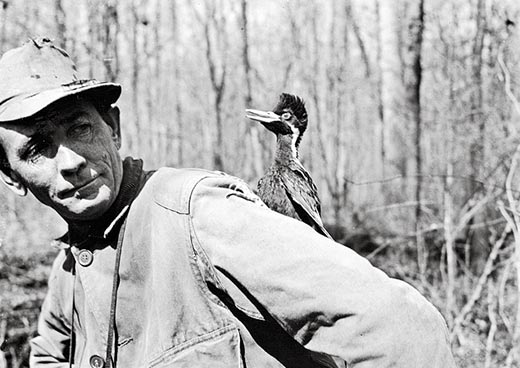
August 19, 2010

James T. Tanner’s photographs of the ivory-billed woodpecker with guide J.J. Kuhn were believed to be the only pictures of a living nestling.
Photographs by James T. Tanner
Newfound negatives provide fresh views of the young ivory-billed woodpecker
The ivory-billed woodpecker is one of the most extraordinary birds ever to live in America’s forests: the biggest woodpecker in the United States, it seems to keep coming back from the dead. Once resident in swampy bottomlands from North Carolina to East Texas, it was believed to have gone extinct as early as the 1920s, but sightings, confirmed and otherwise, have been reported as recently as this year.
The young ornithologist James T. Tanner’s sightings in the late 1930s came with substantial documentation: not only field notes, from which he literally wrote the book on the species, but also photographs. In fact, Tanner’s photographs remain the most recent uncontested pictures of the American ivory-bill. Now his widow, Nancy Tanner, has discovered more photographs that he took on a fateful day in 1938.
Tanner was a doctoral candidate at Cornell University when, in 1937, he was sent to look for ivory-bills in Southern swamplands, including a vast virgin forest in northeast Louisiana called the Singer Tract. Two years earlier, his mentor, Arthur Allen, founder of the Cornell Laboratory of Ornithology, had proved that the “Lord God” bird—so named for what people supposedly exclaimed after getting a look at its 20-inch body and 30-inch wingspan—was still extant, with observations of several adult ivory-bills in the same forest.
“There are relatively few references to young Ivorybills,” Allen wrote in 1937, “and there is no complete description of an immature bird.” But that would soon change.
On his initial solo trip to the Singer Tract, Tanner became the first person to provide such a description, after watching two adults feed a nestling in a hole they’d carved high in a sweet gum tree. “It took me some time to realize that the bird in the hole was a young one; it seemed impossible,” he scribbled in his field notes. When he returned to those woods in early 1938, he discovered another nest hole, 55 feet off the ground in the trunk of a red maple. And in it he discovered another young ivory-bill.By Stephen Lyn Bales
Smithsonian magazine, September 2010
Read the entire article and see additional photos at Smithsonian.com.
About Craig Woolheater
Co-founder of Cryptomundo in 2005.
I have appeared in or contributed to the following TV programs, documentaries and films:
OLN's Mysterious Encounters: "Caddo Critter", Southern Fried Bigfoot, Travel Channel's Weird Travels: "Bigfoot", History Channel's MonsterQuest: "Swamp Stalker", The Wild Man of the Navidad, Destination America's Monsters and Mysteries in America: Texas Terror - Lake Worth Monster, Animal Planet's Finding Bigfoot: Return to Boggy Creek and Beast of the Bayou.
Filed under Bigfoot Report, Books, Breaking News, Cryptotourism, Evidence, Eyewitness Accounts, Ivory-Billed Woodpecker, Photos